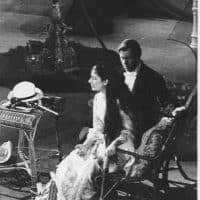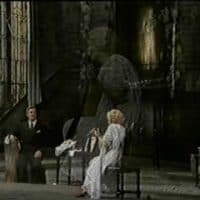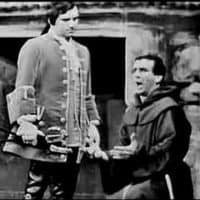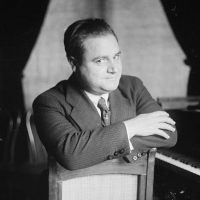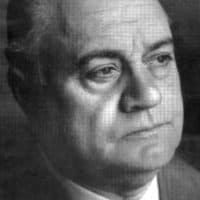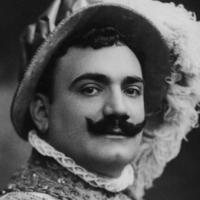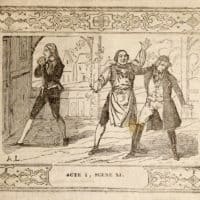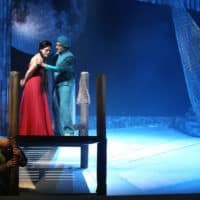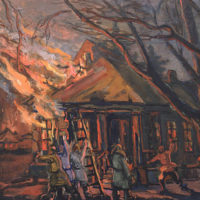1
 The number of tenors throughout the first half of the twentieth century considered great exponents of the role of Otello ever since Francesco Tamagno premiered Giuseppe Verdi’s opera in 1887 at La Scala, can be counted on the fingers of one hand. Without a doubt one of them was Icilio Calleja who became the second tenor after Tamagno to sing this demanding role at the same opera house, after he was auditioned and subsequently chosen by a La Scala Commission chaired by Arrigo Boito and Tullio Serafin, much to the consternation of other Italian tenors who felt, they were being discriminated against to favour a ‘foreign’ singer!
The number of tenors throughout the first half of the twentieth century considered great exponents of the role of Otello ever since Francesco Tamagno premiered Giuseppe Verdi’s opera in 1887 at La Scala, can be counted on the fingers of one hand. Without a doubt one of them was Icilio Calleja who became the second tenor after Tamagno to sing this demanding role at the same opera house, after he was auditioned and subsequently chosen by a La Scala Commission chaired by Arrigo Boito and Tullio Serafin, much to the consternation of other Italian tenors who felt, they were being discriminated against to favour a ‘foreign’ singer!
The true nationality of Icilio Calleja has, for many years, been shrouded in mystery and many biographers have been content to rest on a false assumption that he was Spanish, (sometimes Spanish/Jewish, Italian or even Egyptian), a misleading detail which various publications, including dictionaries, have continued to furnish incorrectly. Others have since been content to follow them blindly and incorrectly along the same path.
Calleja’s grand-father was born in the small town of Zebbug on the Island of Malta. A cook by profession in the employ of a Maltese noble family, he decided to leave
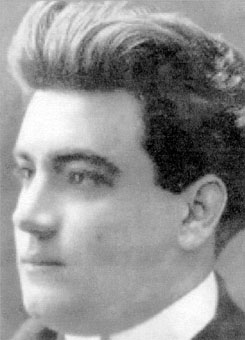
Malta, and together with his wife and children emigrated to Alexandria. His son Giovanni, who later became one of the Directors of the Anglo-Egyptian Bank, married a young lady by the name of Concetta Polito who had come to Alexandria from Corfú. In 1882 the British attacked Alexandria and the newly married Giovanni with his now pregnant wife decided to get out of Egypt. They were undecided whether to travel to Malta or to Corfú but to keep the wife happy, Corfú was the chosen destination. Their child was born on the 25 June, 1882 and was registered in the baptismal records of Corfú with the names of Antonio, Federico, Icilio Calleja, destined to become one of the world’s leading tenors. In an interview published in 1924 in the Italian newspaper “Il Piccolo” of Trieste, Icilio Calleja explained how his family had moved to Alexandria and later to Corfú but declared that his family came from Malta, and that he was proud to be Maltese.
When the bombardment of Alexandria had ceased and the British entered Egypt, all those that had sought refuge elsewhere, including the Calleja family returned to Alexandria. The young Icilio’s inclination towards the art of singing began to manifest itself at an early stage and already at the age of 18 he took the leading part in a musical comedy “Pauvre Gilles” by F. Poise which took place in one of the small theatres of Alexandria. This did not meet the full approval of his father who urged his son to enter university and obtain a good degree. Icilio Calleja was sent to Paris where for four years studied law and graduated from the University of La Sorbonne.
He returned to Alexandria with his new degree, but more determined than ever to continue with his singing lessons which he had concurrently taken up while studying law in Paris!
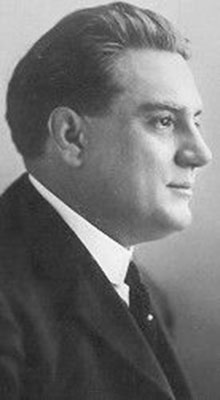
Icilio Calleja continued his vocal training under the guidance of Prof. Luigi Calise and on the 15 January, 1904 appeared in a concert singing two baritone arias: “Aux troupes du Sultan” from Massenet’s Roi de Lahore and “Si puo”, the Prologue from I Pagliacci by Leoncavallo. This was followed by other concert appearances at the New Khedivial Hotel in Alexandria.
Encouraged by the success of these concerts which now also found the support of his father, Icilio Calleja left Alexandria for Italy to further his vocal studies with Maestro Marco Foa’. Recognizing the potential of Calleja’s talent, Mro Foa’ took great interest in his student and prepared him for the role of Canio. The Pagliacci performance with Emma Carelli as Nedda was a resounding success and took place on the 2nd June, 1906 at the Teatro Verdi in Firenze in the presence of the composer, Ruggiero Leoncavallo who predicted an international career for the Maltese tenor.
Icilio Calleja returned to Milan and it was here that he signed his first contract as a fully fledged professional singer which brought his first important engagement of his career. After auditioning for impresario Gatti-Casazza and Arturo Toscanini, at the age of 25 Calleja made his debut at the Teatro alla Scala, Milan, on the 3rd March 1907 with the role of Hagenbach in Catalani’s La Wally conducted by Toscanini. There were five performances in all and the cast included Eugenia Burzio, Pasquale Amato, Nazzareno de Angelis, Adele Ponzano and Amelia Campagnoli. In the review “Ars et Labor” issued in April 1907, Giulio Ricordi remarked that Calleja’s vocal talent revealed an attractive timbre and a powerful voice.
The next engagement came on the 22nd September 1907 when he sang Aida at the Teatro Sociale in Mirandola with Davidos, Bergamasco and Viglione-Borghese. Three months later Calleja was heard in Sansone e Dalila at the Teatro Comunale in Ferrara. The beginning of 1908 brought a new opera when on the 30th January, Icilio Calleja sang Umberto Giordano’s Siberia. Other members of the cast included Lina Fochesato, Viglione-Borghese, Fabbro and Novelli. The Ferrara audience again welcomed Calleja with a serata d’onore held on the 29 of February when pigeons were flown in the auditorium carrying ribbons with “Al Tamagno Egiziano” printed on them.
The string of successes was interrupted with Calleja’s next engagement at La Scala when Verdi’s La Forza del destino was staged on the19 March 1908. He was not in the original cast but had been called in at the last minute to substitute for the Polish tenor Ignacio Dygas. In Lanfranco Rasponi’s book “The Last Prima Donnas”, (Publishers Alfred A. Knopf – New York 1982), Ester Mazzoleni who sang the role of Eleonora recalled: “You cannot imagine what happened in the opening night all hell broke loose in the house after the tenor started ‘O tu che in seno agli angeli’ too soon and off key. The poor man, Icilio Calleja, was frightened to death. As is often the case when the audience gets worked up, it vented its anger in all directions; and before we had the time to realize it, the civilized atmosphere had turned to that of a bullring. Pasquale Amato and Luisa Garibaldi, two singers very much in favour, were booed and hissed mercilessly. I cannot begin to describe to you the state I was in, for until the final scene the only ones who had been saved from the furies were de Angelis and I”.
For some years Calleja kept away from the La Scala Opera House and its audience. On the 1st May 1908 he sang Un Ballo in maschera at the Teatro Massimo in Palermo with Druetti, Petri and Galeffi in the cast. Engagements continued to come in and on the 11th August of the same year he was the Radames of the Aida production at the Teatro Fenice in Senigallia, with Boninsegni, Marchesini, Comune and Carrozzi.
Early in 1909 preparations in Cairo were immediately taken in hand when it became known that Icilio Calleja had been engaged to sing performances of Aida at the
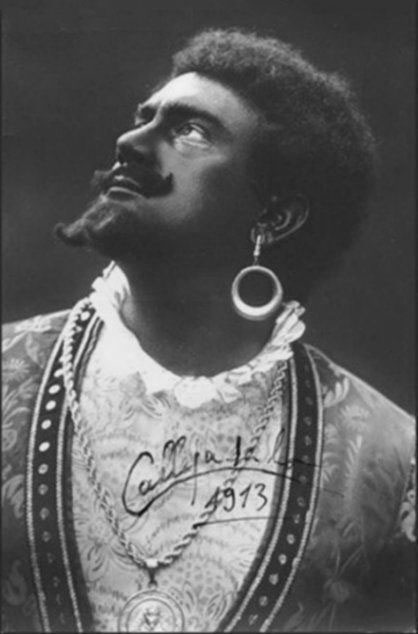
Source: Emy Scicluna’s personal archives.
Khedivial Theatre. There was great enthusiasm among opera lovers brought about by the news that the famous tenor was returning to his country of adoption to sing in the same theatre in which Verdi’s opera had been premiered in 1871. The first performance with Calleja, Burzio, Alvarez and Romboli took place on the 25 February. For many years Icilio Calleja would recall the scenes of jubilation that took place every night after the performance, when crowds would wait outside the theatre near his horse-drawn carriage. They would then release the horses and pull the carriage themselves all the way to his hotel amid scenes of great joy.
In the following months he added another role to his repertoire when Romano Romani, handed the score of his new opera Zulma to Calleja. The premiere performance with Burzio, Calleja, Edoardo Faticante and Oreste Carozzi took place at the Teatro Goldoni at Livorno with success on the 30 November 1909. The composer publicly declared that the part of Feodor was so well interpreted by Calleja that it would be indeed difficult for any other singer to surpass him. Romani’s opera was performed once again as a serata d’onore for Calleja in the same theatre, on the 5th September 1910 conducted by Tullio Serafin. The reviewer of “Il Telegrafo” showered words of praise and called Icilio Calleja “Il Napoleone dei Tenori”!
Between 1910 and 1911 Icilio Calleja was heard in two new roles, Walter in Catalani’s Loreley at the Teatro Verdi in Firenze and as Federico in Franchetti’s Germania at the Teatro Carlo Felice in Genova. He had also appeared in Sansone e Dalila at Modena’s Teatro Municipale under the baton of Mro Guarnieri.
The Rivista Teatrale Melodrammatica of the 18 May, 1911 issued in Milan dedicated a full page to the career of Icilio Calleja with a resume’ of reviews reproduced from various Italian newspapers such as “Patria”, “Corriere di Friuli”, “Giornale” of Udine, “Gazzetta” and “Gazzettino” of Venice, “Resto del Carlino”, “Popolo Romano”, “Caffaro”, “Avanti”, “Paese” and “Adriatico”. Discerning critics were singing their praises regarding Calleja’s powerful voice and dramatic style, his refinement in vocal control, impeccable diction and skilful use of the stage make-up.
The year 1912 brought Calleja’s confirmation to his renown of being the finest interpreter of Samson et Dalila when it was produced at the Teatro Ponchielli in Cremona. The press reports brought rave reviews: La Provincia – “Calleja un tenore magnifico, dalla voce squillante, e dall’accento appassionato abbiamo ricevuto l’impressione the fosse risorto it re dei tenori, Francesco Tamagno!” Interessi Genovesi: “… it piu’ perfetto Sansone della scena lirica, anzi egli puo’ benissimo considerarsi it Sansone dei tenori italiani e stranieri”. Among his many accolades Icilio received a gold medal and an autographed photo inscribed by Saint-Saens: “A mon meilleur Samson” over the composer’s signature.
During the first five years of his career, Calleja was heard in all the major opera houses of Italy and his only sortie outside the Italian peninsula had taken him to Egypt. But finally on the 21 December 1912, he signed his first American contract with the Impresa Dippel to join the Chicago Grand Opera Company. These engagements included performances of Leoncavallo’s I Pagliacci and Wolf-Ferrari’s I Gioielli della Madonna in Chicago, and Aida in New York. Calleja was also heard in Philadelphia, Baltimore, and Cincinnati. Other artists engaged for the opera tour included Enrico Caruso, Amadeo Bassi and Giovanni Zenatello.
The crowning moment of his career came in 1913. The year started with successful performances of Sansone e Dalila and Zulma at the Teatro Margherita in Cagliari. The rest of the cast were Segura-Tallien, Krismer, Armentano and Pini-Corsi. Celebrations in Italy marking the centenary birth of Verdi and Wagner engendered great activity at the Teatro alla Scala. The Commission set up for the specific purpose of organising these festivities decided on a production of Otello which had not been staged there for 26 years since Francesco Tamagno had created this role. After holding a number of auditons, both Arrigo Boito and Tullio Serafin who chaired the Commission were decided on the best choice for the title-role which fell on Icilio Calleja. Letters in the press complained that the special occasion called for a choice of an Italian tenor rather than a foreigner. Tullio Serafin kept firm and reiterated that the Commission opted for the best interpreter and in the circumstances the Commission’s decision was final. The rest of the cast was made up of Linda Cannetti, Mario Sammarco, Giuseppina Bertazzoli, Romeo Boscacci and Berardo Berardi. The three performances that followed achieved a resounding success. There were thirteen extra performances throughout that season and at one stage Claudia Muzio replaced Cannetti.

In order to portray as faithfully as possible the role of Otello, Calleja had made an in-depth study of the effects of convulsions, jerking and facial congestion that are brought about by a fit of epilepsy. He would then put them to good use in Act III when the Moor is overcome by his rage and emotion and falls in a swoon. The Italian newspaper “Adriatico” of the 24 November 1913 reported that Arrigo Boito felt duty bound to visit Calleja in his dressing room after the third act, to congratulate him for his excellent portrayal which he rated as the finest since Tamagno.
In 1914 after returning to La Scala with Smareglia’s opera L’Abisso with Ernestina Poli-Randacio, Claudia Muzio, Berardo Berardi and Emilio Bione, Calleja repeated the role of Otello in Parma in the company of Tedeschi-Baldassare and Luigi Montesanto. The Gazzetta di Parma reported; “…E sovente nel corso della rapprezentazione, scoppiavano scrosci irrefrenabili di applausi che alla fine di ogni atto divenivan ovazioni unanimi, formidabili…alla fine dell’opera it pubblico rimase in teatro altri venti minuti circa per far un ovazione lunghissima, delirante a tutti gli interpreti ed al tenore Calleja, piu’ specialmente, che voile alla ribalta anche da solo, varie volte…” Days later Icilio Calleja left Italy and travelled to Spain to sing Otello at the Real Teatro in Madrid with Galiardi and Montesanto. Following this performance Calleja was invited to the Royal Palace to meet Donna Isabella.
From this period onwards Calleja was in constant demand to sing Verdi’s Moor, at the Teatro Grande in Brescia, where he was awarded a gold medal inscribed “Al grande Otello – Icilio Calleja – Carnevale 1915 – La deputazione del Teatro Grande”, Liceu Barcelona, Teatro dell’Opera Rome, San Carlo Naples, Teatro Bellini Catania, and at the Royal Opera House in Valletta, Malta.
He visited Malta on two occasions, and being of Maltese blood, he was feted with great enthusiasm and accorded a warm welcome as one of its great sons. His visit during the 1919 – 20 opera season to sing Sansone e Dalila on the 29 December1919 and again on January 1 and 2, followed by an extra matinee performance by general request held on Sunday January 4, evoked such emotional manifestations of genuine pride and affection culminating in his soiree d’honneur on January 9, 1920. Hand bills printed on silk were also distributed. The return of Icilio Calleja for his second and last appearance at the Royal Opera House in Valletta, was the artistic event of the season when he sang Verdi’s Otello on the 12, 14, 18 and 21 March 1923.
His last appearance at La Scala came with Spontini’s Fernando Cortez which received five performances during the 1916 – 17 opera season. The first performance took
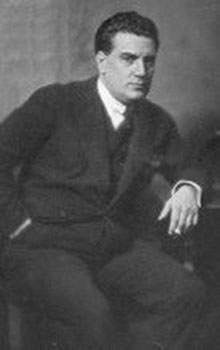
personal archives.
place on the 26 December and the cast included Ester Mazzoleni, Giuseppe Danise, Teofilo Dentale, Gaudio Mansueto and Francesco Merli, conducted by Ettore Panizza. By this time, Icilio Calleja began to turn his attention to the baritone repertoire and on the 16 October 1917, he appeared in the role of Gerard in Giordano’s Andrea Chenier at the Teatro Costanzi, Rome. In Brescia he s9ng Tonio in Pagliacci at the Teatro Sociale. It is to be remembered that before taking up his singing studies in Italy, at the age of 18 Calleja was singing the baritone repertoire. That at the late stage of his career he was experiencing difficulties with the tenor tessitura might have been a plausible explanation for reverting to baritone parts as well as to the Wagnerian repertoire. Between 1920 and 1925, Calleja appeared at Torino’s Politeama Chiarella, the Teatro Municipale of Reggio Emilia, Politeama in Firenze, Teatro Donizetti in Bergamo, Teatro Verdi in Trieste, the San Carlo in Naples and Teatro Comunale in Bologna, with Walkiria (Siegmund), Tristano e Isotta (Tristano), and Sigfrido (Sigfrido). These performances were occasionally interspersed with productions of Sansone e Dalila, Otello and La Wally.
After 1925 his singing engagements appear to have been less frequent and it is recorded that in 1929 he sang for the last time at the Teatro Regio of Parma in the title role of Wagner’s Siegfried.
When the time came to hang his harp, he returned to Alexandria where he spent the last years of his retirement with his family. Icilio Calleja died in his sleep on the 18 November, 1941. With the announcement of his demise, eulogies appeared in “Le Progres Egyptien” and “The Egyptian Gazette” as well as other leading newspapers. As a tribute to his art, a large photo of Icilio Calleja hangs at the Museum of the Teatro alla Scala in Milano.1The recorded legacy of Icilio Calleja committed to acoustic 78s between 1909 and 1918 released on the Fonotipia, Pathe’ and Columbia labels consists mainly of circa 20 excerpts of operatic arias as well as scenes supported by other Italian artists from the following operas: VERDI – Aida and Otello; PUCCINI – La Fanciulla del West; FRANCHETTI – Germania; GIORDANO – Andrea Chenier; LEONCAVALLO- Pagliacci; BIZET- Carmen; MASCAGNI – Isabeau; he also recorded the Inno di Garibaldi.
